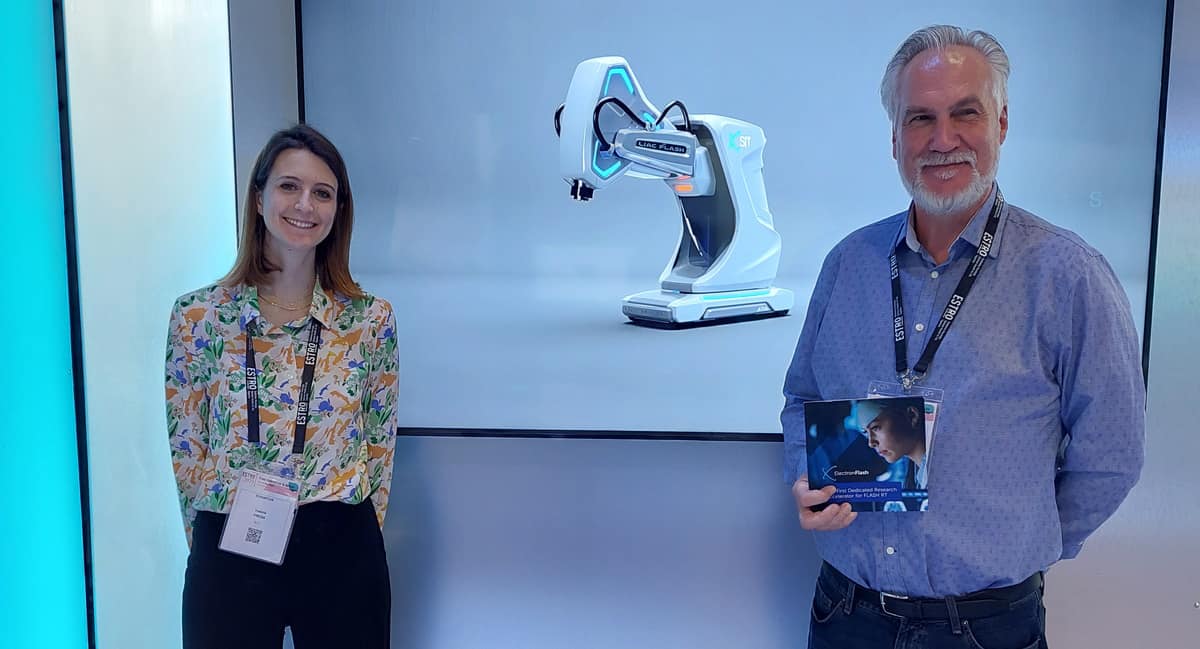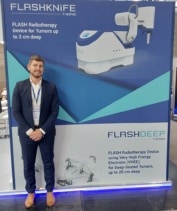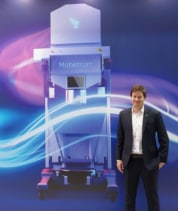The ESTRO 2023 congress saw exhibitors highlight a range of electron beam-based FLASH radiotherapy systems

FLASH radiotherapy, in which radiation is delivered at ultrahigh dose rates (40 Gy/s or above), offers promise to spare healthy tissue while still effectively killing cancer cells. This so-called FLASH effect has been demonstrated extensively in preclinical studies over the past few years, with the first patient treatment taking place in 2019 and results from a first in-human trial reported last year.
At the recent ESTRO 2023 congress in Vienna, FLASH featured heavily among the scientific presentations. And the technique was also making an impact at the trade show. “At ESTRO, we noticed that interest in FLASH is really high,” said Valeria Preda from Italian radiotherapy specialist SIT. “Ninety percent of the people who have visited us are more interested in FLASH.”
SIT was showcasing its ElectronFlash system, a dedicated research accelerator for FLASH radiotherapy. Preda noted that the first system was installed at Institut Curie in France (the site at which Vincent Favaudon first reported the FLASH effect back in 2014), with further systems installed in Antwerp University, Pisa University and shortly also in Madrid (where the first patients will be treated with ElectronFlash within the frame of a clinical trial).
Designed for pre-clinical studies on cells, organoids and small animals, the ElectronFlash comes in three versions, with energy ranges of 5–7, 7–9 and 10–12 MeV, and a dose rate adjustable between 0.005 and 10,000 Gy/s. The system allows for modification of the dose-per-pulse, pulse width and pulse repetition frequency, and can be installed in any standard radiotherapy bunker.
Alongside its pre-clinical offering, SIT is also developing a clinical device – the LIAC FLASH – designed for both clinical and research applications. Preda explained that SIT’s LIAC system was originally developed for intra-operative electron radiotherapy (IOeRT), in which radiation is delivered during a tumour excision operation using a beam of electrons.
IOeRT works by delivering a single dose of irradiation, or as a boost to reduce the number of fractions, to a surgically exposed tumour or tumour bed, whilst the normal tissues are protected by retraction or using a temporary inserted shield. The FLASH workflow will be similar to IOeRT with a new developed device, explained SIT/Vertec Scientific’s David White, but much faster, with irradiation times reduced from minutes to milliseconds.
The team is now working on CE certification for the LIAC FLASH, which will offer both conventional IOeRT and FLASH dose rates, and market launch is predicted for the first half of 2025. The new system will address all the IOeRT indications currently included within ESTRO, ASTRO and NCCN guidelines. “I see FLASH technology being the next big step forward for IOeRT,” White told Physics World.
Deep treatment
Also exhibiting its latest FLASH technology offerings was THERYQ, a spin-off of French manufacturer PMB-ALCEN. PMB developed the Oriatron electron linear accelerator, employed for early FLASH studies and used at Lausanne University Hospital (CHUV) for the first FLASH treatment of a patient.

Building on this expertise, THERYQ developed FLASHKNiFE, a mobile treatment system that combines an ultrahigh dose rate (up to 350 Gy/s) electron linac with an interactive robot. The system delivers electron beams with energies of 6 to 10 MeV, and can treat at depths of up to 3 cm. The company released the first prototype machine in 2021 and is soon to start clinical trials in four European centres, including CHUV.
The initial trial is designed to demonstrate the safety of the system when used in external-beam treatments of skin cancer, with CE certification slated for 2025. A second trial next year will study the use of the FLASHKNiFE for intra-operative radiotherapy of head-and-neck and visceral tumours.
Alongside, THERYQ is developing a second system, FLASHDEEP, that will be able to treat solid tumours anywhere in the body. “We are now working in collaboration with CHUV and CERN to develop a FLASH system capable of targeting any tumour at any depth,” explained the company’s CEO Ludovic Le Meunier.
The FLASHDEEP accelerator is based on compact linear collider (CLIC) technology developed by CERN, which generates very high-energy electron (VHEE) beams with energies of 100 to 200 MeV and enables treatment of tumours at depths of up to 20 cm. The VHEE beams are distributed into three beamlines, which converge towards the patient isocentre to provide conformal treatment.
The system will deliver doses of 2 to 30 Gy and employ real-time pulse-to-pulse control to enable treatment times of less than 100 ms. Since the system will not involve a gantry, THERYQ intends to use an upright patient positioning system (from Leo Cancer Care) for treatments.
The system is being developed at CHUV, with full installation expected in mid-2025. After that, the company hopes to install a second machine in Institut Gustave Roussy in Paris, followed in 2027 by a system at IUCT, the Cancer University Institute of Toulouse, and another at a US site. “If we do what we say we’re going to do, I think there will be a big shift,” Le Meunier told Physics World.
Adapting an established platform
Elsewhere on the ESTRO show floor, US electron therapy specialist IntraOp presented the application of its Mobetron electron-beam linear accelerator for preclinical and investigational FLASH radiotherapy studies. The company points out that Mobetron is the first to provide ultrahigh-dose rate electron therapy for FLASH research using an established clinical radiotherapy platform, and the first being used in human clinical trials of FLASH radiotherapy with electrons, with two clinical protocols (IMPulse and LANCE) already approved.

The IntraOp Mobetron is a mobile, self-shielded machine designed to deliver intra-operative radiotherapy (IORT) to cancer patients during surgery. Now in established clinical use at dozens of cancer centres, clinics and teaching hospitals around the world, the system delivers beam energies of 6, 9 and 12 MeV to treat at depths of up to 4 cm.
Philip von Voigts-Rhetz, clinical application specialist at IntraOp, explained that to move to FLASH irradiation, the company used the identical clinical platform but modified key beam parameters.
“It took some time to adjust key parameters and get a stable and reproducible beam, with large field sizes that could be used for patient irradiation,” he said. “Then three years ago we delivered the first FLASH system and we now have 10 installations at leading cancer centres and universities worldwide.”
One major obstacle in the use of FLASH radiotherapy is the difficulty in performing accurate dosimetry at ultrahigh dose rates, where conventional ion chambers exhibit beam perturbation and saturation effects. To overcome this, the Mobetron incorporates two beam-current transformers (BCTs) to provide real-time monitoring of the output and energy of pulsed electron FLASH beams.

Radiotherapy innovation on show at ESTRO
A study performed at the MD Anderson Cancer Center demonstrated that BCTs can accurately monitor the FLASH beams, quantify accelerator performance and capture essential physical beam parameters on a pulse-by-pulse basis. In the future, IntraOp proposes that BCTs could also be used for active control of electron FLASH beams.
Von Voigts-Rhetz noted that the modified Mobetron can operate at both conventional and ultrahigh dose rates. “One system can be used for clinical IORT in the day for patient treatments, and then turn into a FLASH system for research, ensuring the fastest path to clinical implementation of FLASH radiotherapy,” he told Physics World.
- SEO Powered Content & PR Distribution. Get Amplified Today.
- PlatoAiStream. Web3 Data Intelligence. Knowledge Amplified. Access Here.
- Minting the Future w Adryenn Ashley. Access Here.
- Buy and Sell Shares in PRE-IPO Companies with PREIPO®. Access Here.
- Source: https://physicsworld.com/a/flash-radiotherapy-creates-a-stir-at-estro-trade-show/
- :has
- :is
- :not
- :where
- $UP
- 000
- 10
- 100
- 12
- 20
- 200
- 2014
- 2019
- 2021
- 2023
- 2025
- 30
- 7
- 9
- a
- Able
- above
- accelerator
- accurate
- accurately
- active
- address
- adjustable
- After
- ago
- All
- allows
- already
- also
- among
- an
- and
- animals
- Another
- any
- anywhere
- Application
- applications
- approved
- ARE
- around
- AS
- At
- back
- based
- basis
- BE
- Beam
- been
- being
- between
- Big
- body
- boost
- both
- but
- by
- CAN
- Cancer
- Cancer cells
- capable
- capture
- Cells
- centres
- ceo
- Certification
- click
- Clinical
- clinical trials
- collaboration
- COM
- combines
- comes
- company
- Company’s
- Congress
- control
- conventional
- converge
- could
- creates
- Currently
- David
- day
- dedicated
- deliver
- delivered
- delivering
- delivers
- demonstrate
- demonstrated
- depth
- Depths
- designed
- develop
- developed
- developing
- device
- Difficulty
- distributed
- do
- dozens
- during
- Early
- effect
- effectively
- effects
- electrons
- employed
- enable
- enables
- energy
- ensuring
- essential
- established
- European
- exhibit
- Exhibiting
- exhibitors
- expected
- expertise
- explained
- exposed
- extensively
- faster
- fastest
- featured
- few
- field
- First
- Flash
- Floor
- followed
- For
- Forward
- four
- FRAME
- France
- French
- Frequency
- from
- full
- further
- future
- generates
- get
- going
- guidelines
- Half
- Have
- he
- healthy
- heavily
- High
- Highlight
- hopes
- hospitals
- HTTPS
- human
- i
- identical
- image
- Impact
- implementation
- in
- included
- Including
- indications
- information
- initial
- Innovation
- install
- installation
- installed
- Institute
- intends
- interactive
- interest
- interested
- into
- involve
- issue
- ITS
- jpg
- Key
- large
- Last
- Last Year
- latest
- launch
- leading
- less
- machine
- major
- Making
- Manufacturer
- Market
- max-width
- MEV
- Minutes
- Mobile
- modified
- Monitor
- monitoring
- more
- move
- MS
- much
- New
- next
- normal
- noted
- now
- number
- obstacle
- of
- offer
- offering
- Offerings
- Offers
- on
- open
- operate
- operation
- or
- originally
- out
- output
- over
- Overcome
- parameters
- paris
- past
- path
- patient
- patients
- People
- percent
- performance
- performing
- physical
- Physics
- Physics World
- Place
- platform
- plato
- Plato Data Intelligence
- PlatoData
- points
- positioning
- predicted
- Presentations
- presented
- promise
- proposes
- protected
- protocols
- prototype
- provide
- pulse
- Radiotherapy
- range
- Rate
- Rates
- real-time
- really
- recent
- reduce
- Reduced
- released
- Reported
- research
- Results
- robot
- Safety
- Said
- say
- Science
- scientific
- Second
- see
- Shield
- shift
- Shortly
- show
- Show Floor
- showcasing
- similar
- since
- single
- sit
- site
- sizes
- Skin
- small
- solid
- some
- soon
- specialist
- standard
- start
- Step
- Still
- Stir
- studies
- Study
- Surgery
- system
- Systems
- taking
- targeting
- Teaching
- team
- Technology
- temporary
- than
- that
- The
- The Future
- the world
- then
- There.
- think
- this
- three
- thumbnail
- time
- times
- to
- took
- towards
- trade
- transformers
- treat
- treatment
- trial
- trials
- true
- TURN
- two
- Universities
- university
- us
- use
- used
- using
- very
- visited
- von
- was
- we
- What
- when
- which
- while
- Whilst
- white
- WHO
- width
- will
- with
- within
- working
- works
- world
- worldwide
- year
- years
- zephyrnet













